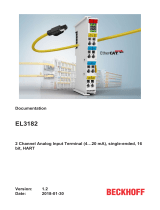Page is loading ...

©Copyright 2012 Dwyer Instruments, Inc. Printed in U.S.A. 11/12 FR# R1-443432-00 Rev.2
Series FDT Flush Diaphragm Transmitter
Specifications - Installation and Operating Instructions
B
ulletin E-FDT
S
PECIFICATIONS
Service: Compatible liquids and gases, adhesives, slurries, materials that can
harden, or where a pressure cavity is not desired.
Wetted Materials: 316 & 15-5 SST.
Accuracy: ±0.5% FSO (includes non-linearity, hysteresis, and repeatability).
S
tability: ≤ ±0.25% FSO per year.
T
emperature Limits: -40 to 200°F (-40 to 93°C).
C
ompensated Temperature Limits: 0 to 170°F (-18 to 77°C).
Pressure Limit: 150% FS; Burst: 200% FS.
Thermal Effect: ±1.5% FSO over compensated range.
Power Requirements: 8 to 38 VDC.
Output Signal: FDT-A: 4 to 20 mAdc; FDTV: 0 to 5 VDC.
R
esponse Time: <1mS.
Loop Resistance: FDT-A: 0-1.5 Ω; FDT-V: ≤ 100 Ω.
Electrical Connections: Bendix 4 pin.
Process Connection: 7/16-20 UNF Male Flush Diaphragm. Optional 1/4” male
NPT.
Enclosure Rating: NEMA 4x (IP66).
Mounting Orientation: Mount in any position.
Weight: 2 oz (57 g).
Agency Approvals: CE.
T
he Series FDT Flush Diaphragm Transmitter is designed for highly cyclical
conditions. This unit has a non-oil filled sensor element that provides resistance to
temperature fluctuations. Manufactured from a solid piece of steel, the sensing
diaphragm can withstand the most abrasive/cyclical applications. Unit performs
well in high cyclical environments with the presence of water-hammering or
s
piking.
F
lush feature greatly reduces chance of leakage. Tough materials allow the unit to
w
ithstand harsh process conditions. Advanced manufacturing techniques, extreme
environmental burn-in, and thorough residual stress relieving procedures ensure
unit will maintain its high performance standard over time.
INSTALLATION
Location
Select a location where the temperature of the transmitter will be between -40 and
200°F (-40 to 93°C). Distance from the receiver is limited only by total loop
resistance. The tubing or piping supplying pressure to the unit can be practically
any length required but long lengths will increase response time slightly.
Position
The transmitter is not position sensitive. However all standard models are originally
calibrated with the unit in a position with the pressure connection downward.
Although they can be used at other angles, for best accuracy it is recommended
that units be installed in the position calibrated at the factory.
Pressure Connection
Use a small amount of plumbers tape‚ thread tape or other suitable sealants to
prevent leaks. Be sure the pressure passage inside the port is not blocked.
Electrical Connections
Units must “see” the proper excitation to perform within specifications. Insufficient
power may prevent the unit from providing the full rated output at the full rated
pressure. Electronics can be damaged by electric surges. Surge arresters are
suggested for applications where surges are possible. Mechanical isolation may
also be required. Electrical termination must be made in a NEMA 4 enclosure.
Care must be taken to prevent migration of fluid into the cable jacket. Unless
otherwise specified, the unit’s electronics should not be exposed to temperatures
above 250°F.
Note: Wrench only on the wrench flats for mounting or removing the unit. Do not
use the housing or electrical termination for wrenching. The pressure cavities of
FDT series unless otherwise specified are manufactured with 15-5 and 316
stainless steels and are suitable for use with all media compatible with those
materials. Foreign objects should not be introduced into the pressure cavity. Units
must be protected from exposure to transient pressure spikes and pressures over
their rated proof pressure range.
CURRENT (4 to 20 mA) OUTPUT OPERATION
An external power supply delivering 8 to 38 VDC with minimum current capability
of 40 mA DC (per transmitter) is required to power the control loop. See Fig. A for
connection of the power supply, transmitter and receiver. The range of appropriate
receiver load resistance (RL) for the DC power supply voltage available is
expressed by the formula:
RL Max = Vps - 8
20 mA DC
Shielded cable is recommended for control loop wiring.
VOLTAGE (0 to 5 V) OUTPUT OPERATION
(Other output contact the factory) See Fig. A for connection of the power supply,
transmitter and receiver.
MAINTENANCE
After final installation of the pressure transmitter and its companion receiver, no
routine maintenance is required. A periodic check of system calibration is
suggested. The Series FDT transmitters are not field reparable and should be
returned if repair is needed (field repair should not be attempted and may void
warranty). Be sure to include a brief description of the problem plus any relevant
application notes. Contact customer service to receive a return goods authorization
number before shipping.
7/16-20 UNF
1.00
FLUSH
DIAPHRAGM
0.525
0.400
BENDIX 4 PIN
CONNECTOR
DTIH-8-4PN
1˝ HEX
VITON O-RING
2.250
3.25(REF)
0-5 VDC
0 - 5 or 0 - 10 VDC MODEL
7/16-20 UNF
FLUSH
DIAPHRAGM
VITON O-RING
2.50(REF)
0.400
1.00
1˝ HEX
0.525
BENDIX 4 PIN
CONNECTOR
DTIH-8-4PN
4 - 20 MA
A
D
B
C
Standard Wiring
MODEL
FDT-V
FDT-A
OUTPUT
0-5 VDC 3 Wire
4-20 mAdc
Power(+)
Pin A
Pin A
Power(-)
Pin B
Signal(+)
Pin C
Pin B
Fig. A
Do not exceed specified supply voltage ratings. Permanent
damage not covered by warranty will result. This device is not
designed for 120 or 240 volt AC operation. Use only on 8 to 38 VDC.
C
AUTION
DWYER INSTRUMENTS, INC.
Phone: 219/879-8000 www.dwyer-inst.com
/

